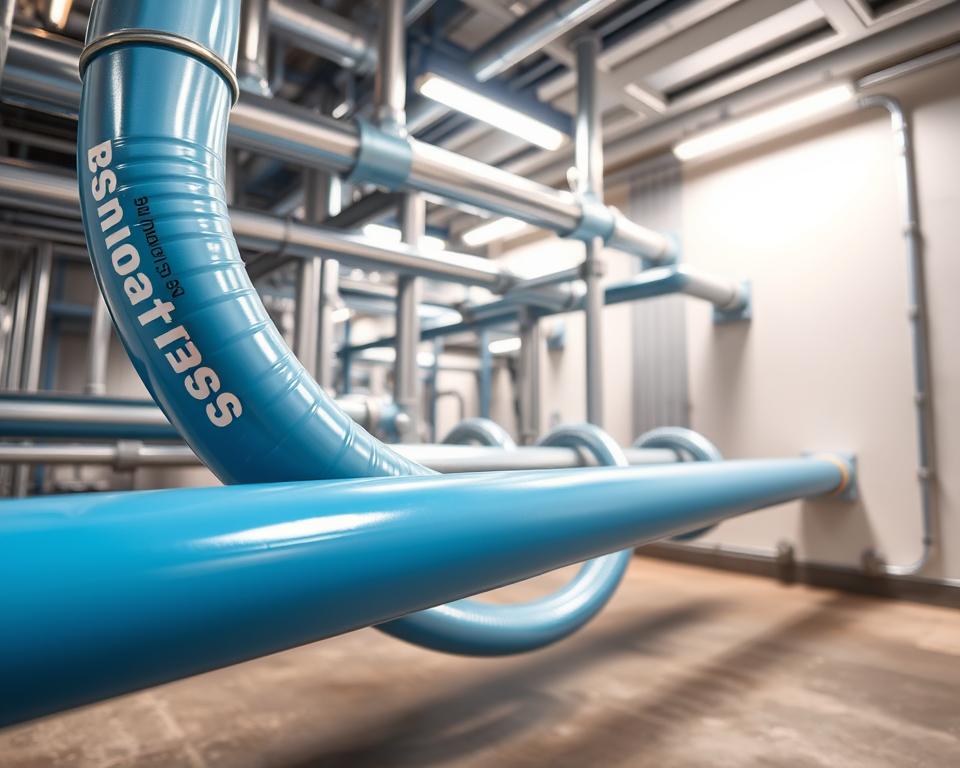PVC Pipe for Air Compressor Lines: Your Complete Guide
Did you know that a ruptured compressed air system can release energy equivalent to a stick of dynamite? Many facilities still use piping systems made from risky materials, unaware of the dangers. Read on to discover why PVC air hose choices demand top-tier safety.
Despite growing interest in certain materials, OSHA strictly prohibits their use in above-ground applications. Over time, exposure to oils and temperature changes weakens them, leading to catastrophic failures. Even at “safe” pressure ratings, the risk of explosions remains high.
Turn to Installation Parts Supply for sturdy aluminum systems. Investing in proper materials avoids costly fines and keeps workplaces secure. Let’s explore how to build a safer system.

Key Takeaways
- OSHA prohibits specific piping for air lines because of blast hazards.
- Pressure ratings drop as temperatures fluctuate.
- Brittleness worsens over time, increasing failure risks.
- Switching to aluminum vastly improves safety.
- Invest wisely to dodge fines and protect staff.
Why PVC Pipe Is Dangerous for Compressed Air Systems
All major brands advise against certain plastics in compressed air. A breach in a pressurized air line unleashes explosive power, unlike water. Select your piping wisely to avoid deadly failures.
- Brittleness: Below-freezing conditions render PVC dangerously brittle.
- Adhesive failures: Temperature changes and oils cause adhesive joints to fail.
- Misleading ratings: Pressure capacity drops 50% at 110°F—most workshops exceed this.
After a PVC burst hurt staff, OSHA levied a $110,000 fine. Compression heating lowers allowable pressure even more—often ignored.
“Above-ground use of certain plastics for compressed air violates OSHA standards due to explosion risks.”
In contrast, metal pipes deform before bursting. Plastic shrapnel from explosive failures can travel over 50 feet, embedding in walls or equipment.
Constant temperature swings in shops speed up pipe aging. Over 10 years, UV exposure and chemical interactions further compromise integrity, turning minor leaks into major hazards.
Recommended Piping Materials for Compressed Air
Modern aluminum systems beat old-school piping on both safety and performance. With 90% fewer leaks than black pipe, they’re a top choice for modern facilities. Aluminum’s lightness and anti-rust traits prolong system life.
Modular aluminum setups save time—no threading required. Installation Parts Supply stocks ready-to-snap aluminum modules. A car plant saw a 40% drop in labor expenses after aluminum installation.
- Copper: Ideal in sterile environments for its germ-killing copper surface. Requires soldering expertise.
- Stainless Steel: Resists rust in humid areas like coastal workshops.
- ABS/HDPE: Plastic choices like ABS or HDPE handle harsh chemicals.
“Our aluminum retrofit reduced energy waste by 15%—paying for itself in 18 months.”
Torque matters. Over-tightened fittings crack, while loose ones leak. Stick to recommended 25–30 ft-lb torque for aluminum.
NSF-approved lines keep food-grade air clean. Pick piping suited to your facility’s conditions.
How to Choose the Right Piping Material for Your Needs
Selecting the best material for your setup requires balancing cost, safety, and efficiency. Switching to aluminum saved a factory $12k each year. Follow these tips to pick wisely.
| Material | Cost (per ft) | Maintenance | ROI Time |
|---|---|---|---|
| Aluminum | $8.50 | Low | 18 months |
| Black Pipe | $5.00 | High | N/A |
| Copper | $10.20 | Medium | 24 months |
Don’t ignore thermal limits. Aluminum handles -40°F to 200°F, while plastics crack below freezing. Use stainless steel where solvents are present.
Pro Tip: Use leak-loss math to estimate ROI. A 10% air leak in 50 HP equals about $3,500 annually.
- Don’t undersize—pick pipe rated at or above your compressor’s PSI.
- Verify your system meets OSHA welding and pressure-test rules.
- Contact Installation Parts Supply for a no-cost audit.
“Our aluminum retrofit cut energy waste by 15%—paying for itself in 18 months.”
Hire pros for big installs to guarantee airtight connections. Don’t forget to read the fine print on warranty lengths.
Conclusion
Choosing the right materials for your compressed air setup isn’t just about cost—it’s about safety. Older systems account for 92% of accidents due to degraded piping. Aluminum offers 99.8% reliability, making it a smart long-term choice.
Don’t forget:
- Never use pipes that can fragment violently.
- Opt for corrosion-resistant metals like aluminum or stainless steel.
- Failing to comply can cost you big in fines and claims.
Upgrade now and secure your workplace. Grab same-day pricing and deals on kits from Installation Parts Supply. Access a complimentary maintenance template or request urgent replacements.
Make safety your piping priority—act today.


